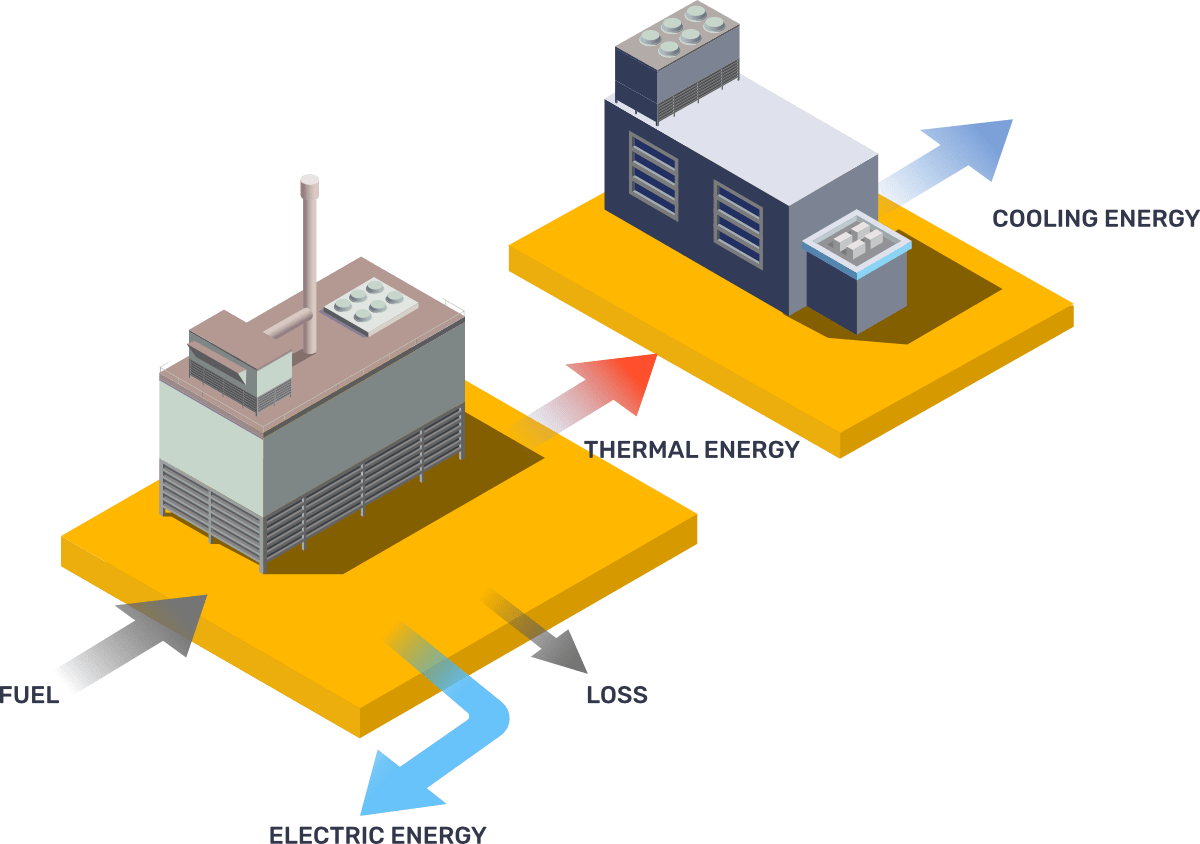In Trigeneration, the production of air or cold water is added to the production of electricity and heat. More technically, the useful thermal energy is partly used to produce chilled water for air conditioning or industrial processes, through absorption refrigerators.
Trigeneration extends the possibilities of Cogeneration, which are intrinsically limited by the need, for the system to be efficient, of the contemporaneity of electrical and thermal users. In fact, this factor represents a limit where, as in the case of domestic and civil users in general, the need for heating is limited to the winter period, while in the summer the cogeneration plant must be kept still or must work by dissipating the heat product. By combining a cogenerator with special absorption refrigerators, which are able to generate cooling energy using heat as a source, rather than electricity, it is possible to exploit the cogeneration systems even in the hot months when the demand for air conditioning is very high, or in industrial sectors where cooling systems are needed.
How it works
A trigeneration plant, similar to a cogeneration plant, consists of the following main components:
- a “prime engine” powered by a fuel
- an electric generator that transforms the mechanical energy of the "prime engine" into electricity
- heat exchangers, to recover the heat lost from the electricity generation process and make it available to users in the form of heat
- absorption chiller which, using part of the recovered heat, generate refrigeration energy.
The production of cooling energy through a heat source is based on the evaporation at low temperature and pressure of a refrigerant fluid, which absorbs heat from the water to be refrigerated; the steam produced is removed by making it absorb by a solution, from which it is separated again by heating. The refrigerants / absorbents used in trigeneration are:
- water / lithium bromide for temperatures up to 4 ° C
- ammonia / water for temperatures up to -60 ° C.
TYPE OF PLANTS FOR INDUSTRIAL AND CIVIL APPLICATIONS
Based on the type of fuel used as "primary energy" we can distinguish:
- Gas trigeneration, if the primary energy is methane gas
- Diesel trigeneration, if is used traditional petroleum derivative
- Biomass trigeneration, where the fuel is represented by timber, wood waste from agricultural or forestry processing, chips of wood chips, biodegradable waste
- Biogas trigeneration, if purified gases deriving from farms, agricultural production or landfills are used
- Biodiesel trigeneration, obtained from renewable sources such as vegetable oils and animal fats
EFFICIENCY AND ADVANTAGES
In a trigeneration system the overall efficiency increases thanks to a better exploitation of the calorific value of the fuel.
While conventional thermoelectric power plants convert about 30% of the fuel energy into electricity and the remaining 70% is lost into heat, with a trigenerator more than 80% of the fuel is used, both as a heating source and as energy to power a absorption cycle for the refrigeration of environments or fluids.
Trigeneration has significant advantages, including:
- a reduction in fuel consumption, thanks to an improvement in the overall efficiency of the system, which with the same amount of primary energy is able to produce electricity, heat and refrigerant
- a reduction in energy transmission losses, thanks to the proximity of the electrical, thermal and cooling energy production plants to the places of consumption
- a consequent reduction of the environmental impact, given that lower fuel consumption contributes to reducing CO2 emissions
- economic savings in the medium / long term, thanks to the lower quantity of fuel consumed and the tax concessions that are currently applied to alternative energy systems
However, it must be considered that: - the optimal yields occur when the demand for electricity, heat and cold by users is almost simultaneous, since they are not easily accumulated
- there is not always a compatibility between the amount of electrical and thermal energy needed
- the proximity between the production site and the energy user is not always achievable
- trigeneration plants are an economically advantageous solution only if the power required by the user exceeds a certain minimum threshold
- the feasibility and convenience of a specific type of trigeneration plant must be assessed on a case by case basis, through a specific initial analysis

The most suitable applications for the use of trigeneration are all production processes in which there is a continuous thermal absorption combined with a simultaneous demand for electricity and cooling systems. This series includes most of the production processes of the manufacturing industry (in particular the plastic one) and food, and the sectors in which there is a need for thermal and cooling energy for use in air conditioning environments, such as healthcare, hotels, sports centers and parks and shopping centers.
Request informations
Skills & Services
Innovation for energy and the environment.
In each project we combine the engineering, technical and technological skills of all the member companies.
A Project Manager takes care of all phases of the project: from the initial feasibility study to installation, up to providing a turnkey system, perfectly tested and complete with staff training services and after-sales assistance.
Services
Request information
Contact
ADDRESS
B E E S GROUP ENERGY LLC-FZ
Meydan Grandstand, 6th floor
Meydan Road, Nad Al Sheba
Dubai, UAE
PHONE
+39 334 8520446